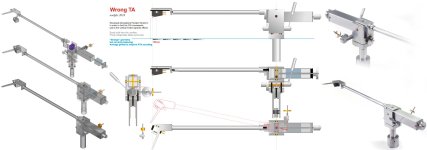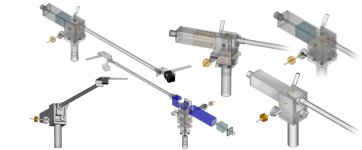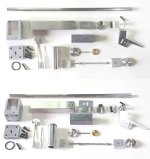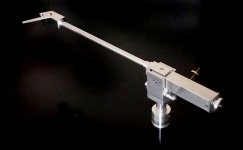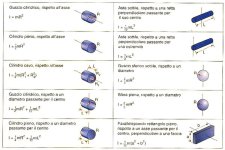Carlo, so long as the parts are weighed and used at the same altitude then g is factored into the mass. The variation in gravity around the globe at sea level is not significant for EM calculation it would be less than mg.
Your calculation needs to add COM distance from the pivot for every component individually. In the attached SS you see column D is the COM distance from the pivot.
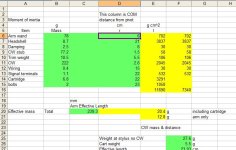
Your calculation needs to add COM distance from the pivot for every component individually. In the attached SS you see column D is the COM distance from the pivot.

Thanks, W. Maybe the spreadsheet i used calculates them on its own (it asks for the distance of the CW, and the length of the wand)
The results were not so different from my hand-made ones.
G -- my doubt is this (+ or - !). Huygens calculates the moment of inertia for any direction (inertial masses), while gravity acts just vertically. So how does it's component on the other directions enter into the calculation?
c
Ps - may you link that spreadsheet? seems better done than mine
The results were not so different from my hand-made ones.
G -- my doubt is this (+ or - !). Huygens calculates the moment of inertia for any direction (inertial masses), while gravity acts just vertically. So how does it's component on the other directions enter into the calculation?
c
Ps - may you link that spreadsheet? seems better done than mine
Hi Carlo,
Impressive all your TA research and execution you have done all these years including this last one. To calculate the effective mass I used the attached chart calculation, looks like yours, but not the distance CW R that seems too short ( 1 Cm ). By the way not sure this chart is 100% correct.
Best regards
Adelmo

Impressive all your TA research and execution you have done all these years including this last one. To calculate the effective mass I used the attached chart calculation, looks like yours, but not the distance CW R that seems too short ( 1 Cm ). By the way not sure this chart is 100% correct.
Best regards
Adelmo
How do you calculate (or judge) the Horizontal EM and resonance on the Niffy carriage please? i see the vertical pivoting around the wheels on the track, and one could calculate for the mass components i am sure, but Horizontal eludes my simple brain!Mike, this is complex subject and very misunderstood....................................
What is actually required is that EM be high enough to prevent the cart body from being thrown around but low enough so as warps and eccentricity do not deflect the CL. Now eccentricity is 0.55Hz and warp varies but is usually in the 5-7Hz region. This means that a TA with higher horizontal EM so resonance is around 2Hz will hold the body still horizontally allowing better tracking of low frequencies. Then lower vertical EM so resonance is above 8Hz will hold the cart still vertically but allowing the arm to rise and fall quicker so these warps do not cause vertical CL deflection. This is why the carriage @niffy designed is so damn good.
Thanks, W. Maybe the spreadsheet i used calculates them on its own (it asks for the distance of the CW, and the length of the wand)
The results were not so different from my hand-made ones.
G -- my doubt is this (+ or - !). Huygens calculates the moment of inertia for any direction (inertial masses), while gravity acts just vertically. So how does it's component on the other directions enter into the calculation?
c
Ps - may you link that spreadsheet? seems better done than mine
The Coriolis effect will have more influence than Gravity on horizontal rotational inertia. This is the effect caused by the rotation of the earth and is why weather systems spin in different directions in Northern and Southern hemispheres. Although a TA might have insufficient mass for the Coriolis effect to have any significant impact.
The spreadsheet can not calculate COM from the pivot as this will vary with different arms and SS does not know which arm you are inputting the data. Although on closer inspection it asks to measure mass at the arm end with CW removed. But then this will measure the mass at something less than the effective length distance, and the formula squares the distance so this will introduce errors.
@Mike56 Horizontal EM is the total mass of the carriage because the movement is linear not rotational.
I don't always agree with Alexis measurement methodology but I think he did a good on this. The link is to the last part of the Tonearm cartridge matching investigations. It's a bit math heavy but just ignore that and you'll get sense of what is happening.
https://korfaudio.com/blog70
Here some details of the construction of the WTA1, a tonearm with an usual BBs gimbal articulations, but with "wrongly" inverted axis.
The construction, starting from adequate profiles (my scrap-bin became very rich...) does not present particular difficulties.
The arm works comfortably (fine adjustment of the VTF, lifter, antiskating), maybe a common user could use it as any commercial TA ; some audiophile would instead remain perplexed, seing his new arm folding in two.
My corcerns about V vs H EM compliance were almost overcome due to a careful dimensioning (weigths / distances). And the measured VTF var. < 0.2 gr throughout the entire tracking of the disc is imperceptible, at least for my ears; there are many "right" TAs - with pivot and cw aligned to wand, instead than to the stylus tip - that have a bigger one on single warps.
The video shows my usual "crash test" on a 3mm warp and + - 1.5mm eccentric - note that on the rear only the A.S. is moving a bit
c
Grazie per le tue gentili parole - for your kindness - Adelmo, I simply enjoy more experimenting than copying, changing instead of perfecting.
Spreadsheets, but also the formulas once found on magazines are only approximations: (for example they do not take into account the different shapes of the masses, (from I =1/2 m*R2 to 1/12 !) useful just for setting up the design. Here to understand that it was mandatory to start from a heavy CW almost stuck to the pivots. In this case a 13x13 bar lead casted, then cut to size after a few tests and mechanical measurements. (the 3d draw shows how it goes so near).
My simple rule is: if the design stumbles the TA will suck anyway, even if carved out of pure tungsten. Few turns of a quick mock up are often enough to understand.
Thanks for the info/hints, Warren - Yeah, even Coriolis! 9.8 m/s2 g was enough for me to worry.
I know, appreciate and rarely don't agree Alexej's great work. I exchanged some emails with him because long ago I also did a couple of TAs on flexy joints. I was pleased that he knew my project on the radial rail concept.
The construction, starting from adequate profiles (my scrap-bin became very rich...) does not present particular difficulties.
The arm works comfortably (fine adjustment of the VTF, lifter, antiskating), maybe a common user could use it as any commercial TA ; some audiophile would instead remain perplexed, seing his new arm folding in two.
My corcerns about V vs H EM compliance were almost overcome due to a careful dimensioning (weigths / distances). And the measured VTF var. < 0.2 gr throughout the entire tracking of the disc is imperceptible, at least for my ears; there are many "right" TAs - with pivot and cw aligned to wand, instead than to the stylus tip - that have a bigger one on single warps.
The video shows my usual "crash test" on a 3mm warp and + - 1.5mm eccentric - note that on the rear only the A.S. is moving a bit
c
Grazie per le tue gentili parole - for your kindness - Adelmo, I simply enjoy more experimenting than copying, changing instead of perfecting.
Spreadsheets, but also the formulas once found on magazines are only approximations: (for example they do not take into account the different shapes of the masses, (from I =1/2 m*R2 to 1/12 !) useful just for setting up the design. Here to understand that it was mandatory to start from a heavy CW almost stuck to the pivots. In this case a 13x13 bar lead casted, then cut to size after a few tests and mechanical measurements. (the 3d draw shows how it goes so near).
My simple rule is: if the design stumbles the TA will suck anyway, even if carved out of pure tungsten. Few turns of a quick mock up are often enough to understand.
Thanks for the info/hints, Warren - Yeah, even Coriolis! 9.8 m/s2 g was enough for me to worry.
I know, appreciate and rarely don't agree Alexej's great work. I exchanged some emails with him because long ago I also did a couple of TAs on flexy joints. I was pleased that he knew my project on the radial rail concept.
Attachments
I tend to agree with warrjon that horizontal resonance wants to be about 2 Hz while vertical resonance about 7Hz. Thus Effective Mass needs to be higher horizontally than vertically.
nocdplz, your designs seem to have EM much lower horizontally than vertically.
nocdplz, your designs seem to have EM much lower horizontally than vertically.
nocdplz, your designs seem to have EM much lower horizontally than vertically.
Seems - because of what? may you explain, pls?
Having designed it, probably I cannot see the problem, and the calculations made* for the project certainly do not help me, since they, quite surprisingly for me too, say the opposite.
All I know was already in the answer # 40
c
*the real measurements obviously may show some variations due to the diying process
Seems - because of what? may you explain, pls?
Having designed it, probably I cannot see the problem, and the calculations made* for the project certainly do not help me, since they, quite surprisingly for me too, say the opposite.
All I know was already in the answer # 40
c
*the real measurements obviously may show some variations due to the diying process
Exactly this is the cause it has different effective masses in the horizontal plane - lower - and the vertical plane - higher.Because it adds to the effective mass. #36
Here instead is like having two separate entities - the vertical one represented by the entire TA - and the horizontal constituted just by the front part, up to the pivot.
In the vertical plane more mass is accelerated, obviously.
Clearly, because the CW does not move in the horizontal plane it has lower moving mass in the horizontal plane than in the vertical plane, but maybe not less Effective mass (inertia) ?
Maybe someone more knowledgeable and scientifically correct than me can chip in here..............
So is the calculation that shows HEM~= VEM (i don't think ~1% variation is likely important) in #40 not correct?Exactly this is the cause it has different effective masses in the horizontal plane - lower - and the vertical plane - higher.
In the vertical plane more mass is accelerated, obviously.
The Excel spreadsheet behind the calculation is for gimballed tonearms. So, no, it is not correct in this case.
Could you kindly explain the difference and show me how the calculation would be corrected please? - are the results are materially different?
I made my own calculations.
The difference is negligible.
Leave my remarks out of consideration.
Sorry for the inconvinience.
The difference is negligible.
Leave my remarks out of consideration.
Sorry for the inconvinience.
When Carlo first got this particular bit in his teeth, there was nothing much for Mike and I to do but grab a beer and sit down to watch.
Other than posting my Cardan arm, I haven't contributed much here because a lot of the conversation just confused me and part of that is that terms are confusing: mass, weight, and force seem to be used interchangeably. That's been true of tonearm discussion forever and I don't have any solution.
Another confusion for me is that I don't understand how a pivoted bar in space, no gravity, can have different effM in any direction with any given force applied. We seem to say something different when we talk about TAs back on Earth and we don't seem to have much conclusive evidence of effM differences changes. warrjon cites Niffy's excellent LTA with it's high H/V ratio and Carlo finds his WTA1/2 arms perform well despite having a deliberate slightly high V/H ratio. I just measured the "VTF"of a static balance TA in both H and V by turning it 90 degrees. They were equal. I think that means equal masses and that arm measured different H and V resonant frequencies.
I started noticing differences in H and V resonant frequency measurements in experimental TAs several years ago and attributed it to the very different amount of material in parts of the twin arm PLTs I was building at the time. The horizontal pivot arms added considerable weight. There's that weight/mass thing, again. The arms H and V resonances were different, but aceptable, and the arms performed very well.
I noticed the same pattern of responses in both commercial and DIY arms and lighter and heavier arms matched to carts with appropriate compliances. The H resonance is more pronounced and centered on one F. The V resonance is less pronounced and unfocused.
I've taken along time to get here, but I'm going to propose that the answer to the effM conundrum may be at the sharp end of the system, specifically the stylus suspension elastomer and its flexibility. When VTF is applied, the suspension compresses a bit vertically, which damps the vertical movement. The horizontal movement is not damped or very little and is free to move more freely. I've designed light and heavy arms with the intention of mounting specific high/low compliance cartridges, but I'm beginning to think, especially after this thread, that effM, and especially V/H effM, may not be that critical and the range of arm/cart matches may be wide and generous.
I have to caveat that my argument may be based on questionable measurements.
Carlo is no way responsible for any of this, but I want to recognize and thank him for his empirical work in building, testing, and sharing so many remarkable TA designs.
Doug
Other than posting my Cardan arm, I haven't contributed much here because a lot of the conversation just confused me and part of that is that terms are confusing: mass, weight, and force seem to be used interchangeably. That's been true of tonearm discussion forever and I don't have any solution.
Another confusion for me is that I don't understand how a pivoted bar in space, no gravity, can have different effM in any direction with any given force applied. We seem to say something different when we talk about TAs back on Earth and we don't seem to have much conclusive evidence of effM differences changes. warrjon cites Niffy's excellent LTA with it's high H/V ratio and Carlo finds his WTA1/2 arms perform well despite having a deliberate slightly high V/H ratio. I just measured the "VTF"of a static balance TA in both H and V by turning it 90 degrees. They were equal. I think that means equal masses and that arm measured different H and V resonant frequencies.
I started noticing differences in H and V resonant frequency measurements in experimental TAs several years ago and attributed it to the very different amount of material in parts of the twin arm PLTs I was building at the time. The horizontal pivot arms added considerable weight. There's that weight/mass thing, again. The arms H and V resonances were different, but aceptable, and the arms performed very well.
I noticed the same pattern of responses in both commercial and DIY arms and lighter and heavier arms matched to carts with appropriate compliances. The H resonance is more pronounced and centered on one F. The V resonance is less pronounced and unfocused.
I've taken along time to get here, but I'm going to propose that the answer to the effM conundrum may be at the sharp end of the system, specifically the stylus suspension elastomer and its flexibility. When VTF is applied, the suspension compresses a bit vertically, which damps the vertical movement. The horizontal movement is not damped or very little and is free to move more freely. I've designed light and heavy arms with the intention of mounting specific high/low compliance cartridges, but I'm beginning to think, especially after this thread, that effM, and especially V/H effM, may not be that critical and the range of arm/cart matches may be wide and generous.
I have to caveat that my argument may be based on questionable measurements.
Carlo is no way responsible for any of this, but I want to recognize and thank him for his empirical work in building, testing, and sharing so many remarkable TA designs.
Doug
"a lot of the conversation just confused me and part of that is that terms are confusing: mass, weight, and force seem to be used interchangeably."
Doug, i believe that's a very relevant factor, and i may be one of the worst culprits, its difficult to fix correctly in your mind that things have mass, whether or not the force of gravity is acting on them turning that into weight, particularly if you live on earth and haven't experienced a no gravity environment.......
And your thoughts on vertical pre-load of the elastomer are interesting as well.
Doug, i believe that's a very relevant factor, and i may be one of the worst culprits, its difficult to fix correctly in your mind that things have mass, whether or not the force of gravity is acting on them turning that into weight, particularly if you live on earth and haven't experienced a no gravity environment.......
And your thoughts on vertical pre-load of the elastomer are interesting as well.
First of all i thank Doug for the appreciation (friends are there to cheer us up) but even more for the arguments raised. This thread, and these provocative arms were born precisely to discuss them from basics, to establish what is right, or less wrong in the design of tonearms, and what is instead to be considered a mechanical nonsense*.
I will try later to answer you on why i raised the question of the G acceleration, and why i think that the eff mass must be the same in any direction; but i have to move among foggy memories, and it will take me some time -
Meanwhile if someone else, much more adequate will discuss those topics, it will be a relief and avoid me to bring in just silly rubbish.
These well known graphs, and also a look at Wiki (moment of inertia etc) will not hurt anyone
carlo
*Maybe one day i will open another thread searching if there is a graphical method to obtain the Loefgren geometry, another topic on which a lot of confusion circulates.
I will try later to answer you on why i raised the question of the G acceleration, and why i think that the eff mass must be the same in any direction; but i have to move among foggy memories, and it will take me some time -
Meanwhile if someone else, much more adequate will discuss those topics, it will be a relief and avoid me to bring in just silly rubbish.
These well known graphs, and also a look at Wiki (moment of inertia etc) will not hurt anyone
carlo
*Maybe one day i will open another thread searching if there is a graphical method to obtain the Loefgren geometry, another topic on which a lot of confusion circulates.
Attachments
- Home
- Source & Line
- Analogue Source
- the "Wrong" Tonearms
